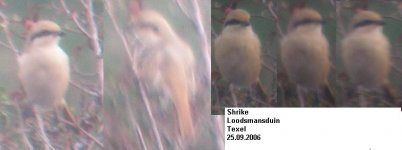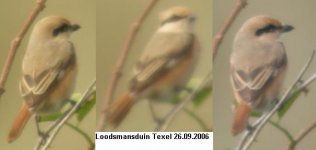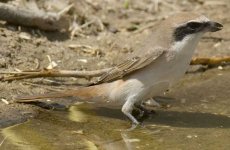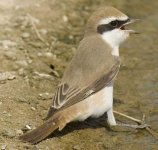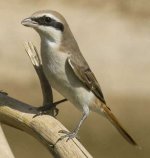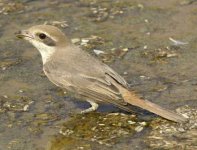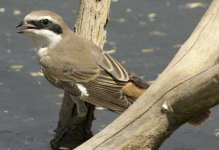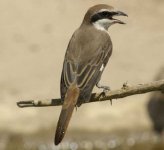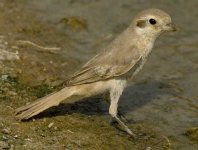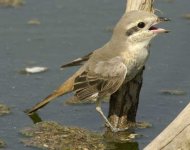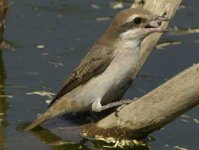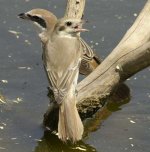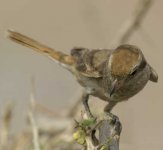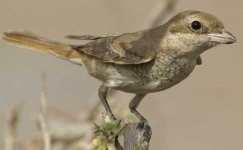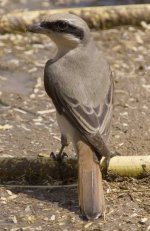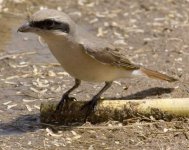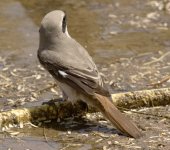-
Welcome to BirdForum, the internet's largest birding community with thousands of members from all over the world. The forums are dedicated to wild birds, birding, binoculars and equipment and all that goes with it.
Please register for an account to take part in the discussions in the forum, post your pictures in the gallery and more.
You are using an out of date browser. It may not display this or other websites correctly.
You should upgrade or use an alternative browser.
You should upgrade or use an alternative browser.
Lanius isabellinus Subspecies ID (2 Viewers)
- Thread starter Joern Lehmhus
- Start date
More options
Who Replied?Jane Turner
Well-known member
My gut reaction is "Daurian" but it has struck me that I have completely forgotten how to tell and all my books are packed!
Awaiting enlightenment!
Awaiting enlightenment!
Xenospiza
Distracted
According to Dutch Birding, it was a Daurian Shrike (isabellinus, formerly known as speculigerus). I didn't go and see this bird, but its crown does indeed look a bit rufous. Are you thinking about a Turkestan Shrike (phoenicurus)?
Anyway, I'll check my special Dutch Birding "Isabelline Shrikes" issue back home...
Better pics (sorry Jörn!) of the same bird:
http://www.dutchbirding.nl/pics/temp/chris-1.jpg
http://www.dutchbirding.nl/pics/temp/chris-2.jpg
http://www.dutchbirding.nl/pics/temp/daurischeklauwier6902.jpg
http://www.birdpix.nl/album_page.php?pic_id=73640
Anyway, I'll check my special Dutch Birding "Isabelline Shrikes" issue back home...
Better pics (sorry Jörn!) of the same bird:
http://www.dutchbirding.nl/pics/temp/chris-1.jpg
http://www.dutchbirding.nl/pics/temp/chris-2.jpg
http://www.dutchbirding.nl/pics/temp/daurischeklauwier6902.jpg
http://www.birdpix.nl/album_page.php?pic_id=73640
Last edited:
David Norgate
Well-known member
Richard Bonser has posted an informative pic on Surfbirds (British Rarities) showing the number of visible primaries - might be of some use.
It is a well marked and coloured (are they true colours?) individual and this would point to Turkestan Shrike (phoenicurus)
but my gut reaction is adult Daurian
It is a well marked and coloured (are they true colours?) individual and this would point to Turkestan Shrike (phoenicurus)
but my gut reaction is adult Daurian
JANJ
Well-known member
http://www.freewebs.com/richbonser/recentphotographs.htm
Looks like Daurian, weak supercilium, buff cheek, pale bill base.
JanJ
Looks like Daurian, weak supercilium, buff cheek, pale bill base.
JanJ
Joern Lehmhus
Well-known member
Xenospiza said:According to Dutch Birding, it was a Daurian Shrike (isabellinus, formerly known as speculigerus). I didn't go and see this bird, but its crown does indeed look a bit rufous. Are you thinking about a Turkestan Shrike (phoenicurus)?
Anyway, I'll check my special Dutch Birding "Isabelline Shrikes" issue back home...
Better pics (sorry Jörn!) of the same bird:
http://www.dutchbirding.nl/pics/temp/chris-1.jpg
http://www.dutchbirding.nl/pics/temp/chris-2.jpg
http://www.dutchbirding.nl/pics/temp/daurischeklauwier6902.jpg
http://www.birdpix.nl/album_page.php?pic_id=73640
Yup, those photos are much better, hadn´t seen them yet! Thanks!
Should have had a look at Dutch birding.
When we ( my wife and me) stumbled over this bird, my gut reaction also was Daurian Shrike Lanius isabellinus (wasn´t fully sure however) and we tried to get some pics with the camera handheld to the scope (don´t have adapter yet). When I informed a dutch birder who lives on the island and is much more experienced than me, the ID was confirmed (only he thought I was Danish)...We tried again to get some more photos the next day. When I saw the photos at home on the monitor , I was mainly surprised by the amount of reddish in the crown.
This is also well visible on the links...
I am not really doubting the ID by people more experienced with that group than me (consensus seemed to be Daurian), but I´d like to learn more about this ...
Hi Joern,
Well, if I see this bird in Kuwait it is phoenicuroides to me straight away, an isabellinus would have a week, less contrasting mask, sandy grey upperparts very small wing bar, and week wing panel.
phoenicuroides has more rufous tail, rufous grey upperparts and red brownish crown (but upperparts variable), boarder wing bar very easily seen on a perching bird, tertials usually much darker with off white fringes, supercilium is usually white contrasting well with the mask but sometimes it is week, never absent specially in front of eye.
Isabellinus is very common wintering species in Kuwait, while phoenicuroides is very common passage migrant.
I think your bird is phoenicuroides.
Alsirhan
Well, if I see this bird in Kuwait it is phoenicuroides to me straight away, an isabellinus would have a week, less contrasting mask, sandy grey upperparts very small wing bar, and week wing panel.
phoenicuroides has more rufous tail, rufous grey upperparts and red brownish crown (but upperparts variable), boarder wing bar very easily seen on a perching bird, tertials usually much darker with off white fringes, supercilium is usually white contrasting well with the mask but sometimes it is week, never absent specially in front of eye.
Isabellinus is very common wintering species in Kuwait, while phoenicuroides is very common passage migrant.
I think your bird is phoenicuroides.
Alsirhan
Joern Lehmhus
Well-known member
Hi all,
parallel I sent a mail also to the dutch birder from Texel, who had confirmed my ID for that... He said, yes, on photographs the bird seems to have a somewhat rufous crown.
However, he said, isabellinus male may show a slight contrasting crown like this bird. But other features clearly indicating isabellinus male are the unmarked, buffy underparts, hardly contrasting with upperparts. The black mask lacking a light eyebrow and continuing only as a very narrow band on forehead and the light base of bill also say isabellinus.
He had been trapping and observing such birds in Kasakhstan and admits there are some difficult ones, especuially juv/first winter, but this one here is easy by comparison.
As the other features fit to isabellinus very well and this confirms that they can show a rufous crown I feel happy.
Concerning the Danish birder story: I guess it is my fault; I should have spoken German as every proper German does in the Netherlands and not resort to such exotic languages like English
and not resort to such exotic languages like English  ,
,
But actually he wasn´t really wrong - I have some Danish ancestors also...
Main thing is the bird was found, IDed and confirmed.
But one more question: what is the general view concerning speculigerus at the moment (if there is a general view)? Subspecies of isabellinus or species in its own right? In the web you find both , but more often the first version.
And how closely are isabellinus and phoenicuroides now?
parallel I sent a mail also to the dutch birder from Texel, who had confirmed my ID for that... He said, yes, on photographs the bird seems to have a somewhat rufous crown.
However, he said, isabellinus male may show a slight contrasting crown like this bird. But other features clearly indicating isabellinus male are the unmarked, buffy underparts, hardly contrasting with upperparts. The black mask lacking a light eyebrow and continuing only as a very narrow band on forehead and the light base of bill also say isabellinus.
He had been trapping and observing such birds in Kasakhstan and admits there are some difficult ones, especuially juv/first winter, but this one here is easy by comparison.
As the other features fit to isabellinus very well and this confirms that they can show a rufous crown I feel happy.
Concerning the Danish birder story: I guess it is my fault; I should have spoken German as every proper German does in the Netherlands
But actually he wasn´t really wrong - I have some Danish ancestors also...
Main thing is the bird was found, IDed and confirmed.
But one more question: what is the general view concerning speculigerus at the moment (if there is a general view)? Subspecies of isabellinus or species in its own right? In the web you find both , but more often the first version.
And how closely are isabellinus and phoenicuroides now?
Last edited:
Xenospiza
Distracted
Currently, the Isabelline Shrike is treated as follows:
Turkestan Shrike (phoenicuroides).
Daurian Shrike (isabellinus, tsaidamensis).
Chinese Shrike (arenarius).
For taxonomic decisions, more work needs to be done I guess... they're treated as species in the Netherlands, as subspecies elsewhere.
Isabelline Shrikes are confusing... also to the people who described them.
The names were changed when the type specimen of isabellinus turned out to be a Daurian Shrike, not a Chinese Shrike. This meant speculigerus was a junior synonym, and needed to be replaced by isabellinus. For the Chinese Shrike, the next available name was arenarius.
Turkestan Shrike (phoenicuroides).
Daurian Shrike (isabellinus, tsaidamensis).
Chinese Shrike (arenarius).
For taxonomic decisions, more work needs to be done I guess... they're treated as species in the Netherlands, as subspecies elsewhere.
Isabelline Shrikes are confusing... also to the people who described them.
The names were changed when the type specimen of isabellinus turned out to be a Daurian Shrike, not a Chinese Shrike. This meant speculigerus was a junior synonym, and needed to be replaced by isabellinus. For the Chinese Shrike, the next available name was arenarius.
Joern Lehmhus
Well-known member
Thanks Xenospiza,
so part of the confusion in the web seems to be from the change for isabellinus due to the speculigerus becoming a synonyme...
I also found this now - had read it some time ago and darkly remembered some things:
http://www.surfbirds.com/ID Articles/Isabelline.html
so part of the confusion in the web seems to be from the change for isabellinus due to the speculigerus becoming a synonyme...
I also found this now - had read it some time ago and darkly remembered some things:
http://www.surfbirds.com/ID Articles/Isabelline.html
JANJ
Well-known member
During a research trip to Kazakhstan in 2003 Svensson concludes from looking at skins in Almaty,
that while isabellinus in it´s typical form is a a bit more buffish below and with a homogeneous grey-brown head and back and with a less wellmarked supercilium, there´s much overlap in plumage characters between males of isabellinus and phoenicuroides.
The form 'karelini' of phoenicuroides which inhabits deserts and lowlands lack the rufous head and is therefore more confusable with isabellinus. He also concludes that no less than 75% of the females and even more of the immatures are impossible to identify. So, more research is needed!
JanJ
that while isabellinus in it´s typical form is a a bit more buffish below and with a homogeneous grey-brown head and back and with a less wellmarked supercilium, there´s much overlap in plumage characters between males of isabellinus and phoenicuroides.
The form 'karelini' of phoenicuroides which inhabits deserts and lowlands lack the rufous head and is therefore more confusable with isabellinus. He also concludes that no less than 75% of the females and even more of the immatures are impossible to identify. So, more research is needed!
JanJ
Hi all,
Here are some photographs of the two subspecies we usually get in Kuwait, phoenicuroides never winter in Kuwait, so all winter birds are isabellinus and I never saw a wintering bird with dark lores (of course wintering birds could be one sex or both, this unconfirmed!).
One photograph of phoenicuroides shows a faint narrow supercilim.
The first six and ninth photographs are phoenicuroides.
The tenth is isabellinus and phoenicuroides for comparison dark tertials on phoenicuroides compared to pale tertials on isabellinus.
The 8th and 7th for isabellinus.
Alsirhan
Here are some photographs of the two subspecies we usually get in Kuwait, phoenicuroides never winter in Kuwait, so all winter birds are isabellinus and I never saw a wintering bird with dark lores (of course wintering birds could be one sex or both, this unconfirmed!).
One photograph of phoenicuroides shows a faint narrow supercilim.
The first six and ninth photographs are phoenicuroides.
The tenth is isabellinus and phoenicuroides for comparison dark tertials on phoenicuroides compared to pale tertials on isabellinus.
The 8th and 7th for isabellinus.
Alsirhan
Attachments
Last edited:
JANJ
Well-known member
Hi alsirhan and all.
Nice set of images from Kuwait!
As noted before, the change in names, former speculigerus is now isabellinus and speculigerus is now arenarius, which might add to the confusing, but when learned, you might think, it will be less confusing. However that is a truth with a certain modification since hybridization and variation makes it difficult to assess some (many)individuals to species/ssp. So called typical adult males of both isabellinus and phoenicuroides shows a complete black mask (behind and in front of the eye) on phoenicuroides reaching as a band obove bill base and usually broader above and below the eye compared with isabellinus. The obvious pale supercilium of phoenicuroides and usually all blackish bill together with obvious rufous crown contrasting with grey.brown mantle and whitish throat, underparts and undertail coverts with a piinkish-buff wash to the flanks and breast, appearing paler below than isabellinus. White primay patch is shared by both. By contrast isabellinus is a warmer bird, with buffish underparts lacking the contasting whitish throat (some different due to wear and individual variation) usually pale based bill. The pale mantle of isabellinus with the blackish wings makes it a more contrasting bird compared to phoenicuroides.
The Dutch bird is therefore more likely to be isabellinis and not a phoenicuroides.
alsirhans birds appears to be (a suggestion)
1. phoenicuroides
2. phoenicuroides
3. phoenicuroides
4. 1st winter phoenicuroides
5. phoenicuroides
6. phoenicuroides
7. unsure (due to date taken)
8. unsure (due to date taken)
9. phoenicuroides (female)
10. The adult, phoenicuroides, the 1st winter phoenicuroides.
Are these late winter-early spring birds alsirhan?
http://www.birdforum.net/showthread.php?t=34317&highlight=isabelline+shrike
JanJ
Nice set of images from Kuwait!
As noted before, the change in names, former speculigerus is now isabellinus and speculigerus is now arenarius, which might add to the confusing, but when learned, you might think, it will be less confusing. However that is a truth with a certain modification since hybridization and variation makes it difficult to assess some (many)individuals to species/ssp. So called typical adult males of both isabellinus and phoenicuroides shows a complete black mask (behind and in front of the eye) on phoenicuroides reaching as a band obove bill base and usually broader above and below the eye compared with isabellinus. The obvious pale supercilium of phoenicuroides and usually all blackish bill together with obvious rufous crown contrasting with grey.brown mantle and whitish throat, underparts and undertail coverts with a piinkish-buff wash to the flanks and breast, appearing paler below than isabellinus. White primay patch is shared by both. By contrast isabellinus is a warmer bird, with buffish underparts lacking the contasting whitish throat (some different due to wear and individual variation) usually pale based bill. The pale mantle of isabellinus with the blackish wings makes it a more contrasting bird compared to phoenicuroides.
The Dutch bird is therefore more likely to be isabellinis and not a phoenicuroides.
alsirhans birds appears to be (a suggestion)
1. phoenicuroides
2. phoenicuroides
3. phoenicuroides
4. 1st winter phoenicuroides
5. phoenicuroides
6. phoenicuroides
7. unsure (due to date taken)
8. unsure (due to date taken)
9. phoenicuroides (female)
10. The adult, phoenicuroides, the 1st winter phoenicuroides.
Are these late winter-early spring birds alsirhan?
http://www.birdforum.net/showthread.php?t=34317&highlight=isabelline+shrike
JanJ
Hi JanJ and all,
All the 10 photographs were taken in August/September period.
From my 5 years bird watching experience in Kuwait (I started bird watching in August 2001) I have always seen the wintering ssp. (roughly from September to March) with a pale lore only and a pale mask (brownish) from rear end of eye to ear coverts, while that of phoenicuroides only seen briefly on August/September and March/April periods as a migrant species.
Could the wintering ssp. be arenarius? As it was this ssp. found in Arabia and named incorrectly as isabellinus.
It was the wintering ssp. I compared the Dutch bird with that made think it is not isabellinus (because of the dark mask up to forehead).
Here is another bird I photographed today (a wintering ssp.)
From BWPi:
"isabellinus was originally described by Hemprich and Ehrenberg from Arabia; recent examination of Arabian specimens in BMNH by D J Pearson showed that these are all speculigerus. Thus, what is now called speculigerus perhaps has to be renamed nominate isabellinus and what is now nominate isabellinus has to be renamed arenarius Blyth, 1846 (D J Pearson)"
Alisrhan
All the 10 photographs were taken in August/September period.
From my 5 years bird watching experience in Kuwait (I started bird watching in August 2001) I have always seen the wintering ssp. (roughly from September to March) with a pale lore only and a pale mask (brownish) from rear end of eye to ear coverts, while that of phoenicuroides only seen briefly on August/September and March/April periods as a migrant species.
Could the wintering ssp. be arenarius? As it was this ssp. found in Arabia and named incorrectly as isabellinus.
It was the wintering ssp. I compared the Dutch bird with that made think it is not isabellinus (because of the dark mask up to forehead).
Here is another bird I photographed today (a wintering ssp.)
From BWPi:
"isabellinus was originally described by Hemprich and Ehrenberg from Arabia; recent examination of Arabian specimens in BMNH by D J Pearson showed that these are all speculigerus. Thus, what is now called speculigerus perhaps has to be renamed nominate isabellinus and what is now nominate isabellinus has to be renamed arenarius Blyth, 1846 (D J Pearson)"
Alisrhan
Attachments
JANJ
Well-known member
Hi alsirhan.
Could some of them be arenarius you ask? According to some sources very rare west to Irak, and south to Persian Gulf and there´s no confirmed records elsewhere in the region. Pakistan NW. India seems to be the main wintergrounds as far west as this.
Have a look at these arenarius from India and notice the pale wings and coverts, strongly reminding of Isabelline Wheatear. Never has a dark lore as the other 'two' females and males being almost alike in plumage:
http://www.netfugl.dk/pictures.php?id=listpictures&species_id=747
Has an earlier breeding period resulting in an earlier moult with a different moult scedule, a complete post breeding moult before migration, and no pre breeding moult, phoenicuroides usually a partial post breeding moult on breeding grounds (July-Sept.) including the tail and some tertials followed by a complete moult in winter grounds (Nov-Dec-Feb. Mar) while most isabellinus moults complete berfore migration.
Juveniles have a partial moult before leaving the breeding grounds.
Moult is said to be of limited use in identification.
Three nice examples of 1st winter phoenicuroides lastly. althoug one shall be carefull of identifying 1st winters to race/(species?) since many isabellinus and phoenicuroides are similar.
JanJ
http://www.lincsbirdclub.co.uk/articles/isabelline.htm
http://www.orientalbirdimages.org/b..._ID=2401&Bird_Image_ID=784&Bird_Family_ID=198
Could some of them be arenarius you ask? According to some sources very rare west to Irak, and south to Persian Gulf and there´s no confirmed records elsewhere in the region. Pakistan NW. India seems to be the main wintergrounds as far west as this.
Have a look at these arenarius from India and notice the pale wings and coverts, strongly reminding of Isabelline Wheatear. Never has a dark lore as the other 'two' females and males being almost alike in plumage:
http://www.netfugl.dk/pictures.php?id=listpictures&species_id=747
Has an earlier breeding period resulting in an earlier moult with a different moult scedule, a complete post breeding moult before migration, and no pre breeding moult, phoenicuroides usually a partial post breeding moult on breeding grounds (July-Sept.) including the tail and some tertials followed by a complete moult in winter grounds (Nov-Dec-Feb. Mar) while most isabellinus moults complete berfore migration.
Juveniles have a partial moult before leaving the breeding grounds.
Moult is said to be of limited use in identification.
Three nice examples of 1st winter phoenicuroides lastly. althoug one shall be carefull of identifying 1st winters to race/(species?) since many isabellinus and phoenicuroides are similar.
JanJ
http://www.lincsbirdclub.co.uk/articles/isabelline.htm
http://www.orientalbirdimages.org/b..._ID=2401&Bird_Image_ID=784&Bird_Family_ID=198
Hi JanJ,
Thank you very much JanJ, very nice informative links, so our wintering birds could just be a first winter phoenicuroides. I will trap a wintering bird take measurements and see what to come up with (hopefully).
Here is a bird photographed this Autumn (4th Sep. 2006) this one could isabellinus couldn't it?
Here is the status of Isabelline Shrike in UAE from a document (Birds of the United Arab Emirates - annotated checklist) published by Tommy Pedersen at his web site:
http://www.tommypedersen.com/UAE.htm
"Isabelline Shrike Lanius isabellinus
L. i. isabellinus - Daurian Isabelline Shrike - occurs as a common migrant and winter visitor. (This ssp was previously named speculigerus).
On Abu Dhabi Island (and possibly throughout the UAE) isabellinus seems more common than phoenicuroides in winter.
L. i. phoenicuroides - Turkestan Isabelline Shrike - occurs as a common migrant and winter visitor from September to May.
L. i. arenarius - Chinese Isabelline Shrike - not identified in the UAE. Winters Iran to India and is said to occur in Arabia (Originally named isabellinus).
L. i. tsaidamensis - Chinese Isabelline Shrike - not identified in the UAE. Winters to s Iran, Pakistan and India and might occur.
Likely sites: Any area with bushes or trees."
Alsirhan
Thank you very much JanJ, very nice informative links, so our wintering birds could just be a first winter phoenicuroides. I will trap a wintering bird take measurements and see what to come up with (hopefully).
Here is a bird photographed this Autumn (4th Sep. 2006) this one could isabellinus couldn't it?
Here is the status of Isabelline Shrike in UAE from a document (Birds of the United Arab Emirates - annotated checklist) published by Tommy Pedersen at his web site:
http://www.tommypedersen.com/UAE.htm
"Isabelline Shrike Lanius isabellinus
L. i. isabellinus - Daurian Isabelline Shrike - occurs as a common migrant and winter visitor. (This ssp was previously named speculigerus).
On Abu Dhabi Island (and possibly throughout the UAE) isabellinus seems more common than phoenicuroides in winter.
L. i. phoenicuroides - Turkestan Isabelline Shrike - occurs as a common migrant and winter visitor from September to May.
L. i. arenarius - Chinese Isabelline Shrike - not identified in the UAE. Winters Iran to India and is said to occur in Arabia (Originally named isabellinus).
L. i. tsaidamensis - Chinese Isabelline Shrike - not identified in the UAE. Winters to s Iran, Pakistan and India and might occur.
Likely sites: Any area with bushes or trees."
Alsirhan
Attachments
Users who are viewing this thread
Total: 3 (members: 0, guests: 3)




